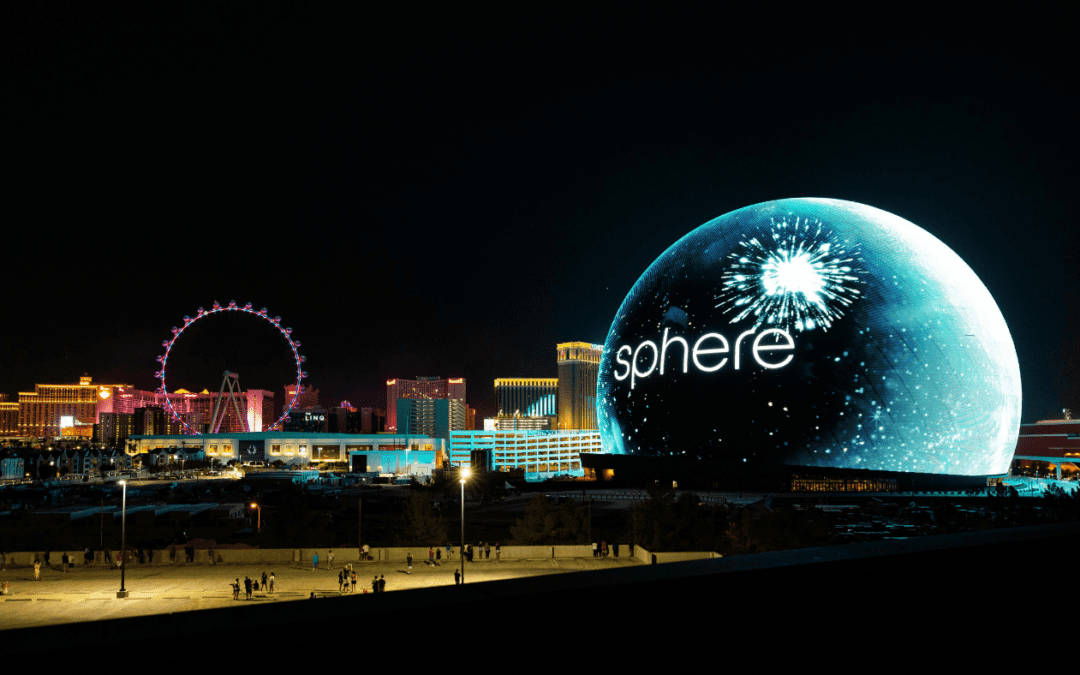July, 2023 — The opening of the Las Vegas Sphere, a spectacular new venue that epitomizes the intersection of architecture, technology, and entertainment, has rightly piqued the interest of businesses worldwide. As brands continuously strive for innovative ways to connect with consumers, the Sphere presents opportunities that are as unprecedented as its structure. Especially notable are the compelling possibilities for digital out-of-home (DOOH) advertising and sponsorship, amplified further by the potential integration of Artificial Intelligence (AI).
The Sphere’s exterior, a mammoth LED screen enveloping the venue, presents an unparalleled DOOH platform. The sheer scale, coupled with high-resolution imaging, makes it an unmissable spectacle for not just those in the vicinity but for global audiences through media coverage. As a result, brands that choose to advertise here will not just buy ad space; they will buy into a unique, immersive experience that guarantees attention.
The Sphere is not just about size; it’s about the depth of engagement. With its cutting-edge technology, brands can curate highly interactive, rich media content, transforming a traditional passive viewing experience into a dynamic one. For instance, brands could host live interactions or immersive AR experiences on the Sphere’s surface, grabbing eyeballs and fostering a stronger connection with the consumers.
Moreover, the Las Vegas Sphere is symbolic of the city’s ethos—excitement, innovation, and uniqueness. Brands that associate themselves with this ethos through sponsorship can significantly enhance their public perception and influence. The Sphere offers a wide range of sponsorship opportunities, from events to specific technologies within the venue, allowing brands to find the right fit for their identity and audience.
But where the Sphere truly outshines other platforms is in its potential to integrate AI technology with advertising. AI can significantly enhance the effectiveness of DOOH and sponsorship efforts. Through AI, brands can employ machine learning algorithms to gather and analyze data from consumers in real-time—information such as viewing habits, emotional responses, and engagement levels. This data can then inform the creation of highly personalized, relevant, and contextually aware content.
Brands can leverage AI to ensure their content responds to real-time events and changes, making the advertisement or sponsorship message much more dynamic and relevant. For example, during a concert, AI could analyze the crowd’s energy levels and dynamically alter the advertising content on the Sphere’s exterior to match the crowd’s mood, increasing engagement and impact.
The Las Vegas Sphere represents an evolutionary step in how we perceive and interact with advertising. It’s not just about grabbing attention anymore, but about creating meaningful, engaging, and dynamic experiences for audiences. By leveraging this platform and integrating AI, brands can take their DOOH advertising and sponsorship efforts to the next level, ensuring they don’t just reach their audiences but truly connect with them.
Concrete examples of how brands could leverage AI in conjunction with advertising at the Las Vegas Sphere:
- Real-time Sentiment Analysis: Brands could deploy AI algorithms to analyze social media conversations and gauge public sentiment during a live event at the Sphere. This could inform real-time tweaks to advertising content displayed on the Sphere’s exterior. For example, if social media posts indicate a spike in excitement during a concert’s particular song, the AI could trigger a brand’s ad that aligns with this high-energy moment, enhancing audience engagement.
- Audience Segmentation: AI could be used to segment the Sphere’s attendees based on collected data—such as demographics, preferences, or past behavior. For instance, during a multi-day tech conference, a tech brand could use AI to identify attendees interested in a specific product. The brand could then display targeted advertisements on the Sphere’s exterior during breaks, maximizing relevance and impact.
- Predictive Analysis: AI could enable brands to anticipate and respond to consumer behavior. For instance, a beverage brand could predict when attendees might be thirsty during an event—based on factors like event duration, temperature, and crowd energy—and display a well-timed ad on the Sphere’s exterior, nudging consumers towards a purchase.
- Interactive Campaigns: Brands could run interactive campaigns on the Sphere’s exterior, with AI serving as the engine behind these experiences. For instance, a fashion brand could host an interactive fashion show, with AI analyzing audience reactions in real-time to determine which designs are the most popular. These findings could then influence the content displayed on the Sphere—perhaps showcasing popular designs in greater detail or providing immediate purchasing options.
- Personalized Advertisements: AI’s ability to handle vast amounts of data can enable deeply personalized advertising. Imagine a car brand knows (via data-sharing agreements) that certain event attendees are in the market for a new vehicle. The brand could display customized car ads on the Sphere, tailored to each individual’s preferences around model, color, and features.
Provided by:
Dennis Hoffmann
Vice President of Business Development
Beeyond Media
dennis.hoffmann@beeyondmedia.com
www.beeyondmedia.com

